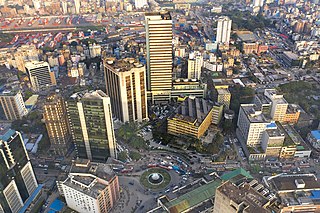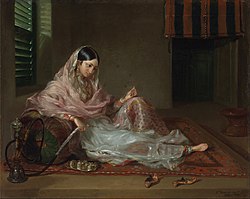
The economy of Bangladesh is a major developing market economy. As the second-largest economy in South Asia, Bangladesh's economy is the 35th largest in the world in nominal terms, and 25th largest by purchasing power parity. Bangladesh is seen by various financial institutions as one of the Next Eleven. It has been transitioning from being a frontier market into an emerging market. Bangladesh is a member of the South Asian Free Trade Area and the World Trade Organization. In fiscal year 2021–2022, Bangladesh registered a GDP growth rate of 7.2% after the global pandemic. Bangladesh is one of the fastest growing economies in the world.

Jute is a long, rough, shiny bast fibre that can be spun into coarse, strong threads. It is produced from flowering plants in the genus Corchorus, of the mallow family Malvaceae. The primary source of the fiber is Corchorus olitorius, but such fiber is considered inferior to that derived from Corchorus capsularis.

Jamdani is a fine muslin textile produced for centuries in South Rupshi of Narayanganj district in Bangladesh on the bank of Shitalakhwa river.

The textile industry is primarily concerned with the design, production and distribution of textiles: yarn, cloth and clothing. The raw material may be natural, or synthetic using products of the chemical industry.

India was one of the richest countries in the world, for about two and a half millennia starting around the end of 1st millennium BC and ending around the beginning of British rule in India.
Certain historical time periods have been named "golden ages", where development flourished, including on the Indian subcontinent.
The study of the history of clothing and textiles traces the development, use, and availability of clothing and textiles over human history. Clothing and textiles reflect the materials and technologies available in different civilizations at different times. The variety and distribution of clothing and textiles within a society reveal social customs and culture.
The role and scale of British imperial policy during the British Raj on India's relative decline in global GDP remains a topic of debate among economists, historians, and politicians. Some commentators argue the effect of British rule was negative, and that Britain engaged in a policy of deindustrialisation in India for the benefit of British exporters which left Indians relatively poorer than before British rule. Others argue that Britain's impact on India was either broadly neutral or positive, and that India's declining share of global GDP was due to other factors, such as new mass production technologies or internal ethnic conflict.
Weaving and cloth trading communities of Western India particularly of Gujarat are called Vankar/Wankar/Vaniya. The four major woven fabrics produced by these communities are cotton, silk, khadi and linen. Today majority of these community members are not engaged in their ancestral weaving occupation still some population of these community contribute themselves in traditional handloom weaving of famous Patola of Patan, Kachchh shawl of Bhujodi in Kutch, Gharchola and Crotchet of Jamnagar, Zari of Surat, Mashroo of Patan and Mandvi in Kutch, Bandhani of Jamnagar, Anjar and Bhuj, Motif, Leheria, Dhamakda and Ajrak, Nagri sari, Tangaliya Shawl, Dhurrie, Kediyu, Heer Bharat, Abhala, Phento and art of Gudri. Vankar is described as a caste as well as a community.

The textiles of Mexico have a long history. The making of fibers, cloth and other textile goods has existed in the country since at least 1400 BCE. Fibers used during the pre-Hispanic period included those from the yucca, palm and maguey plants as well as the use of cotton in the hot lowlands of the south. After the Spanish conquest of the Aztec Empire, the Spanish introduced new fibers such as silk and wool as well as the European foot treadle loom. Clothing styles also changed radically. Fabric was produced exclusively in workshops or in the home until the era of Porfirio Díaz, when the mechanization of weaving was introduced, mostly by the French. Today, fabric, clothes and other textiles are both made by craftsmen and in factories. Handcrafted goods include pre-Hispanic clothing such as huipils and sarapes, which are often embroidered. Clothing, rugs and more are made with natural and naturally dyed fibers. Most handcrafts are produced by indigenous people, whose communities are concentrated in the center and south of the country in states such as Mexico State, Oaxaca and Chiapas. The textile industry remains important to the economy of Mexico although it has suffered a setback due to competition by cheaper goods produced in countries such as China, India and Vietnam.

The Bengal Subah, also referred to as Mughal Bengal, was the largest subdivision of Mughal Empire encompassing much of the Bengal region, which includes modern-day Bangladesh, the Indian state of West Bengal, and some parts of the present-day Indian states of Bihar, Jharkhand and Odisha between the 16th and 18th centuries. The state was established following the dissolution of the Bengal Sultanate, a major trading nation in the world, when the region was absorbed into the Mughal Empire. Bengal was the wealthiest region in the Indian subcontinent.

The history of cotton can be traced to domestication for an important role in the history of India, the British Empire, and the United States, and continues to be an important crop and commodity.
The textile industry is the largest manufacturing industry in Pakistan and nearly 25 million people work in this industry. Pakistan is the eighth largest exporter of textile commodities in Asia. Textile sector contributes 8.5% to the GDP of Pakistan.

Clothing industry or garment industry summarizes the types of trade and industry along the production and value chain of clothing and garments, starting with the textile industry, embellishment using embroidery, via the fashion industry to apparel retailers up to trade with second-hand clothes and textile recycling. The producing sectors build upon a wealth of clothing technology some of which, like the loom, the cotton gin, and the sewing machine heralded industrialization not only of the previous textile manufacturing practices. Clothing industries are also known as allied industries, fashion industries, garment industries, or soft goods industries.

Muslin, a Phuti carpus cotton fabric of plain weave, was historically hand woven in the areas of Dhaka and Sonargaon in Bangladesh and exported for many centuries. The region forms the eastern part of the historic region of Bengal. The muslin trade at one time made the Ganges delta and what is now Bangladesh into one of the most prosperous parts of the world. Of all the unique elements that must come together to manufacture muslin, none is as unique as the cotton, the famous "phuti karpas", scientifically known as Gossypium arboreum var. neglecta. Dhaka muslin was immensely popular and sold across the globe for millennia. Muslin from "India" is mentioned in the book Periplus of the Erythraean Sea, authored by an anonymous Egyptian merchant around 2,000 years ago, it was appreciated by the Ancient Greeks and Romans, and the fabled fabric was the pinnacle of European fashion in the 18th and 19th century. Production ceased sometime in the late 19th century, as the Bengali muslin industry could no longer compete against cheaper British-made textiles.
The economic de-industrialisation of India refers a period of reduction in industrial based activities within the Indian economy from 1757 to 1947. The process of de-industrialisation is an economic change in which employment in the manufacturing sector declines due to various economic or political reasons. The decline in employment in manufacturing is also followed by the fall in the share of manufacturing value added in GDP. The process of de-industrialisation can be due to development and growth in the economy and it can also occur due to political factors.

Piece goods were the textile materials sold in cut pieces as per the buyer's specification. The piece goods were either cut from a fabric roll or produced with a certain length, also called yard goods. Various textiles such as cotton, wool, silk, etc., were traded in terms of piece goods. The prices were determined as per the fabric quality.

Mughal karkhanas were the manufacturing houses and workshops for craftsmen, established by the Mughals in their empire. Karkhana is a Hindustani language word that means factory. These karkhanas were small manufacturing units for various arts and crafts as well as for the emperor's household and military needs. karkhanas were named and classified based on the nature of the job. For example, 'Rangkhana' and 'Chhapakhana' were for textile dyeing and printing work. The term 'tushak-khana' was used to describe workshops that made shawls and embellished them with embroidery or needlework. Imperial or Royal Karkhanas were for luxury goods and weapons. The karkhanas were the place for various production activities and also for the exploration of new techniques and innovations. Some operations such as weaving, embroidery work, and brocade work were often done under one roof, resembling an integrated assembly line.
The economy in the Indian Subcontinent during the Mughal Empire era performed just as it did in ancient times, though now it would face the stress of extensive regional tensions. It was described as large and prosperous. India producing about 28% of the world's industrial output up until the 18th century. While at the start of 17th century, the economic expansion within Mughal territories become the largest and surpassed Qing dynasty and Europe, where from Bengal Subah alone, the province statistically has contributed to 12% of Gross domestic product. by 1700s, Mughals had approximately 24 percent share of world's economy. They grew from 22.7% in 1600, which at the end of 16th century, has surpassed China to become the world's largest GDP.

Shantipur Handloom Industry, also known Shantipur Handloom Cluster, is a handloom weaving industry in Nadia district of West Bengal. It is one of the foremost handloom centers of India. This handloom industry is world famous for the production of cotton Sari (saree). The two main centers of this industrial zone are Shantipur and Phulia. Shantipur has an old reputation for cotton sarees, known as Shantipuri sarees, and Phulia is well known for Tangail-Jamdani sarees.















